French Numbers: How to Count in French from 1-100+ Before Travel to France
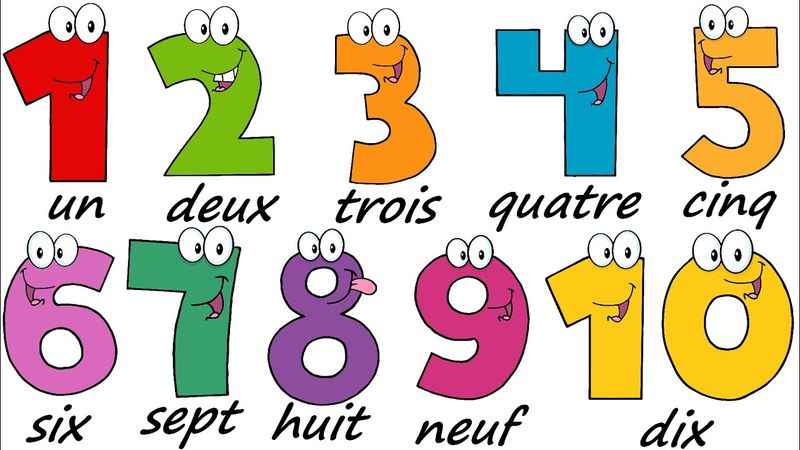
Bonjour and welcome to your guide to learning French numbers! In this post, we will embark on an exciting journey to uncover the secrets of counting in French.
Whether you're a beginner or looking to brush up on your skills, this comprehensive guide will equip you with the knowledge to confidently navigate the world of French numerals.
From the fundamental digits to the more complex numbers extending beyond 100, we will explore each numerical milestone with clarity and precision.
Along the way, we'll also delve into the intricacies of French number pronunciation, ensuring that you not only understand the numbers but can also pronounce them fluently. Get ready to dive into the enchanting realm of French numbers and expand your linguistic horizons.
Before We Get Started

Learning French numbers is an essential skill for anyone planning to travel to France. Beyond just the practicality of everyday interactions, knowing how to count in French enhances your travel experience in numerous ways.
From understanding prices and currency exchanges to reading timetables for trains and buses, mastering French numbers empowers you to navigate with ease and confidence.
Ordering in cafes and restaurants becomes a delightful experience when you can effortlessly communicate quantities and make accurate transactions. Moreover, locals appreciate the effort made to speak their language, and it fosters a deeper cultural connection.
So, embrace the beauty of French numbers before your journey begins, and unlock a world of possibilities during your travels through the charming streets of France. Bon voyage!
Counting in French
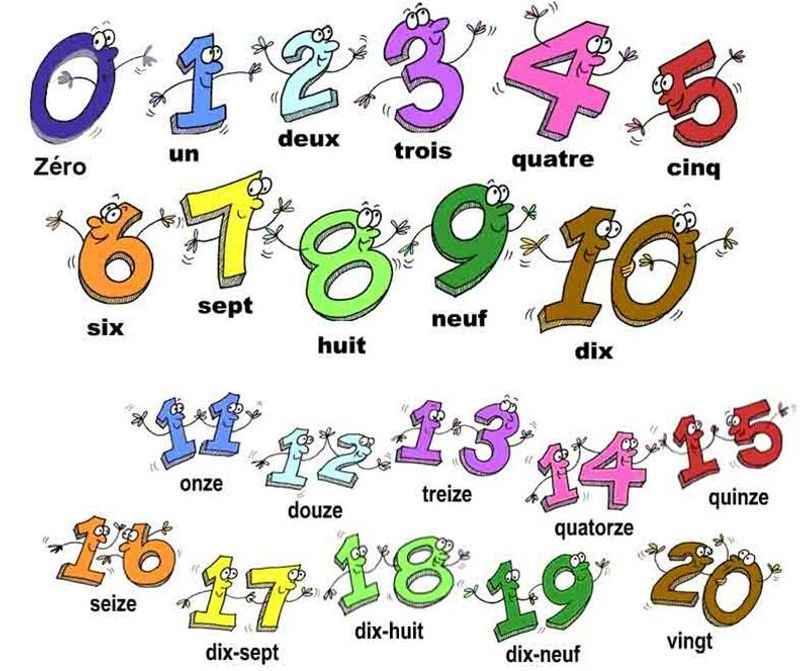
The counting system in French is essentially split into three phases.
The first phase is the numbers 1-16; these give you a base for all other numbers. Once you have these memorized, the rest of the French numbers are simple variations of them.
Below, you will find a list of numbers 1 to 100, grouped together in singles, 10s, 20s, 30s, etc.
Each number will be written in the Arabic numeral system, (1,2,3, etc.), then in French. For the first twenty numbers and the first number of each set, I will spell out the French pronunciation of each number, so that you will know the correct way to say each one.
After you practice a bit, I highly recommend you look up videos or recordings of native speakers saying these numbers so that you can get the pronunciation down.
Now, let's start easy with the single-digit French numbers 1-9.
Numbers 1-9
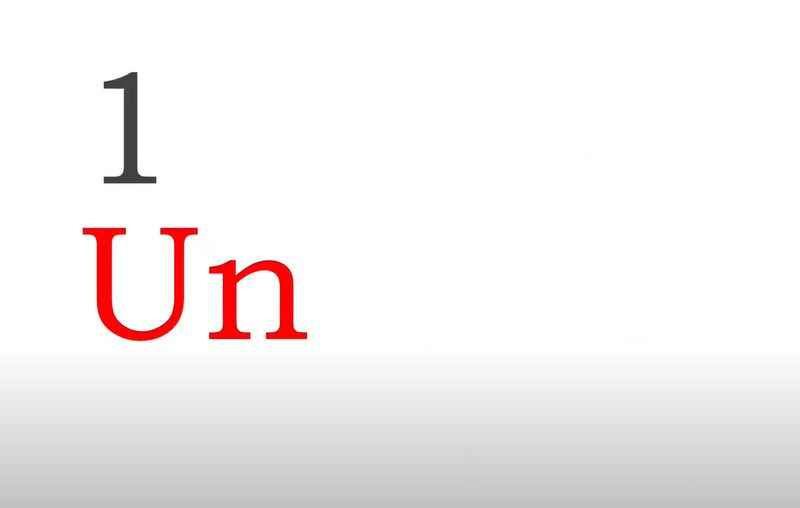
These first nine numbers are the foundation for understanding French numbers pronunciation and for learning how to write out larger numbers.
1 un
2 deux duh
3 trois twah
4 quatre kat-ruh
5 cinq sank
6 six sees
7 sept set
8 huit wheet
9 neuf nuhf
Numbers 10-19
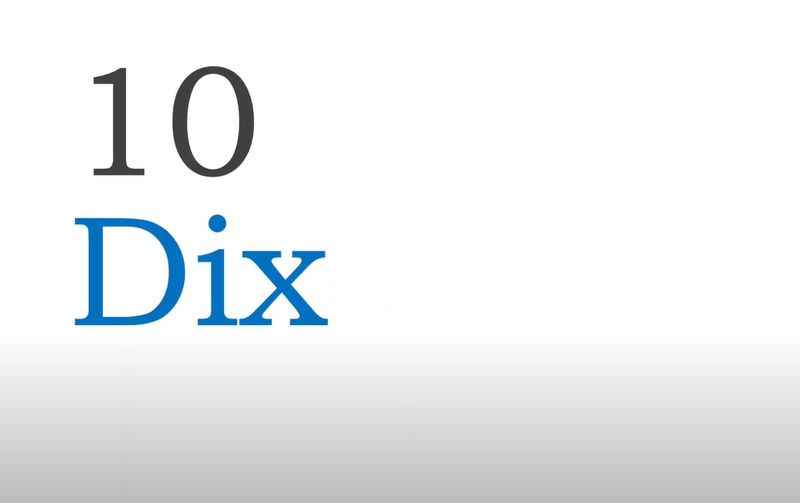
10 dix dees
11 onze onz
12 douze dooz
13 treize trez
14 quatorze kah-tohr-z
15 quinze cans
16 seize sez
From 17 to 69, you will use the tens number and add every single number on the end.
For example, below you will see that the number 17 is dix-sept, which literally means ten-seven.
Each of the below numbers in French will follow this rule up until number 69.
Once we get to number 70, you will see that things get a bit more complicated. For now, just focus on this rule.
17 dix-sept dees set
18 dix-huit dees wheet
19 dix-neuf dees nuhf
Numbers 20-29
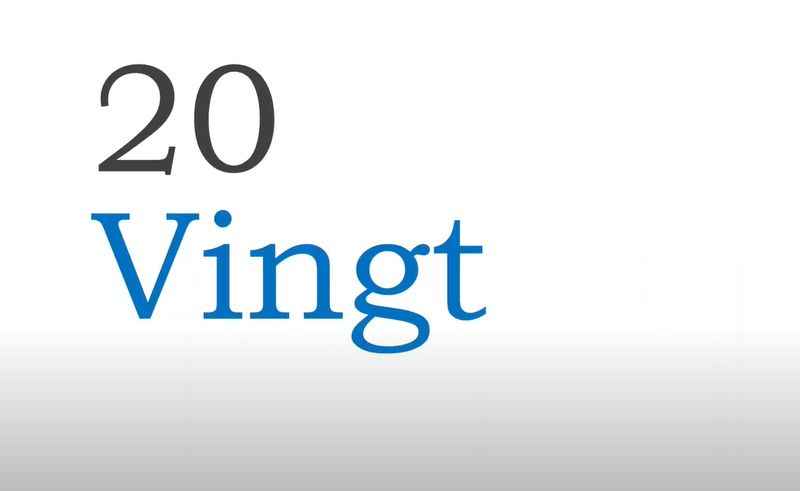
The 20s follow the same rule as the last three 10s except you sill replace dix with vingt or twenty. This will continue with the 30's, 40's, 50's and 60's.
20 vingt van
21 vingt-et-un
22 vingt-deux
23 vingt-trois
24 vingt-quatre
25 vingt-cinq
26 vingt-six
27 vingt-sept
28 vingt-huit
29 vingt-neuf
Numbers 30-39

30 trente tront
31 trente-et-un
32 trente-deux
33 trente-trois
34 trente-quatre
35 trente-cinq
36 trente-six
37 trente-sept
38 trente-huit
39 trente-neuf
Numbers 40-49
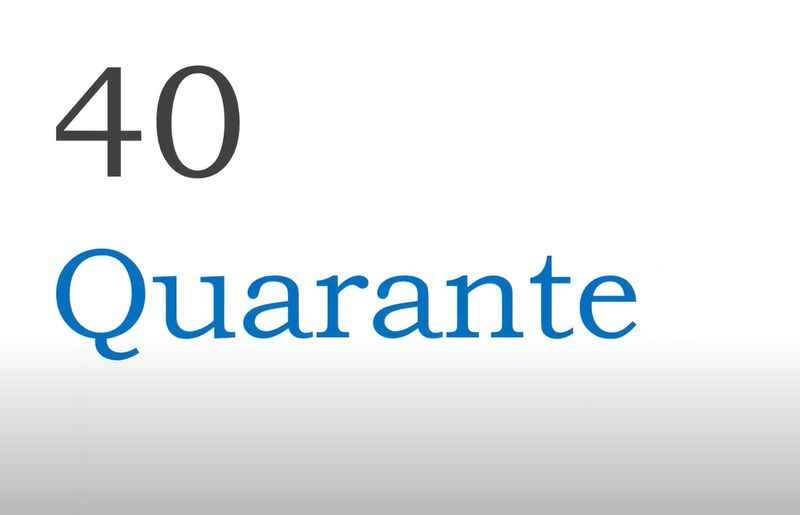
40 quarante ka-ront
41 quarante-et-un
42 quarante-deux
43 quarante-trois
44 quarante-quatre
45 quarante-cinq
46 quarante-six
47 quarante-sept
48 quarante-huit
49 quarante-neuf
Numbers 50-59
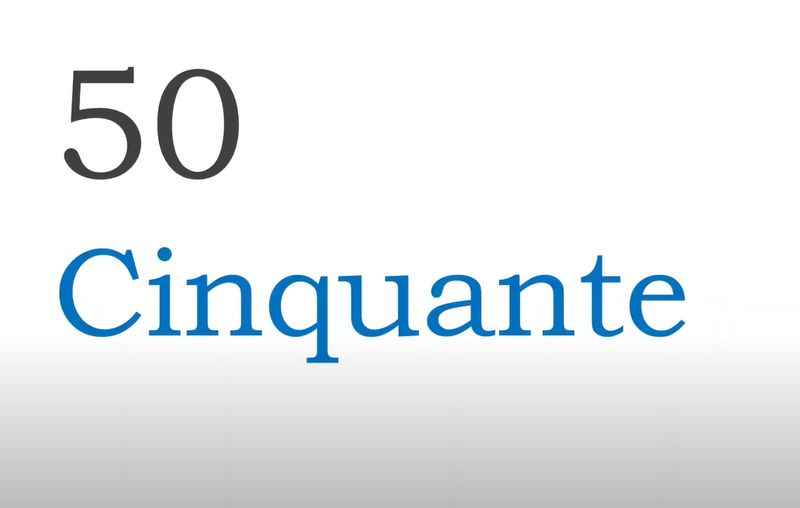
50 cinquante san-kont
51 cinquante-et-un
52 cinquante-deux
53 cinquante-trois
54 cinquante-quatre
55 cinquante-cinq
56 cinquante-six
57 cinquante-sept
58 cinquante-huit
59 cinquante-neuf
Numbers 60-69
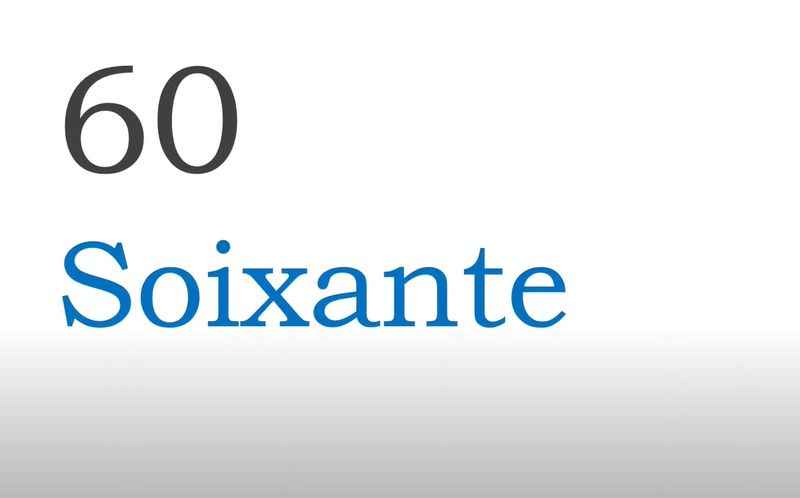
60 soixante swa-sont
61 soixante-et-un
62 soixante-deux
63 soixante-trois
64 soixante-quatre
65 soixante-cinq
66 soixante-six
67 soixante-sept
68 soixante-huit
69 soixante-neuf
Numbers 70-79

This is when things start to get a bit complicated.
Depending on where you visit, you may hear different types of numbers in French.
The reason for this is that in France, people use the numbers in the first column, which requires a bit of math.
Instead of just saying seventy-two, they say sixty-twelve, because sixty plus twelve is 72.
However, if you go to Belgium or Switzerland, you may encounter a different way of counting.
These countries chose not to use the mathematical technique and so the rules above continue to apply to the numbers above 69.
It is best to learn the France version of these French numbers first. Once you figure the math out, the other versions will be a breeze.
Given that it is not essential to learn these versions of the French numbers, the alternatives will only be listed next to each number in this set of 70s.
This way, you will get a glimpse of how it is different.
French Numbers in France Vs Belgium & Switzerland
70 soixante-dix (literally meaning sixty ten) swa-sont dees 70 __septante
71 soixante-onze 71 septante-et-un
72 soixante-douze (sixty twelve) 72 septante-deux
73 soixante-treize 73 septante-trois
73 soixante-quatorze 74 septante-quatre
75 soixante-quinze 75 septante-cinq
76 soixante-seize 76 septante-six
77 soixante-dix-sept 77 septante-sept
78 soixante-dix-huit 78 septante-huit
79 soixante-dix-neuf 79 septante-neuf
Numbers 80-89
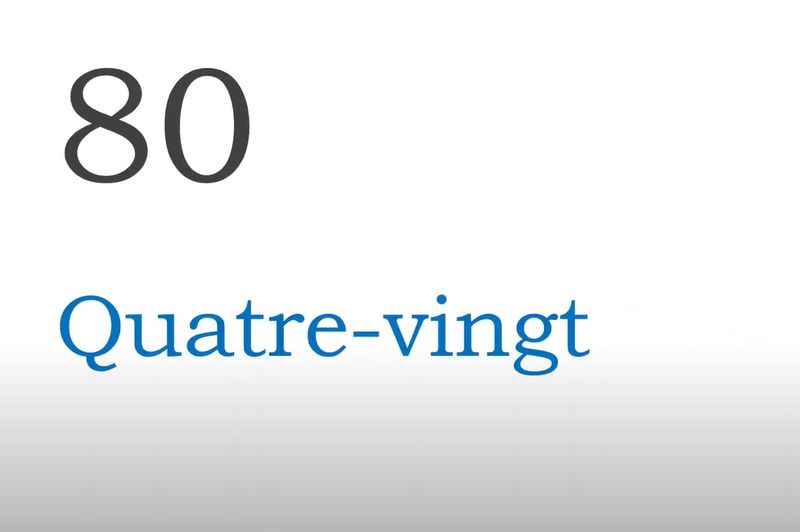
The grouping of eighties starts each number with quatre-vingt, which literally means four twenty because 80 = 4 x 20.
For this grouping, the following numbers will have the French word et in them, which just means and.
A lot of times there will be versions of numbers with et and without et. For this grouping, I have written both versions side-by-side.
80 quatre-vingts (literally meaning four twenties) kat-re van
81 quatre-vingt-et-un (or quatre vingt un)
82 quatre-vingt-et-deux (or quatre vingt deux)
83 quatre-vingt-et-trois (or quatre vingt trois)
84 quatre-vingt-et-quatre (or quatre vingt quatre)
85 quatre-vingt-et-cinq (or quatre vingt cinq)
86 quatre-vingt-et-six (or quatre vingt six)
87 quatre-vingt-et-sept (or quatre vingt sept)
88 quatre-vingt-et-huit (or quarte vingt huit)
89 quatre-vingt-et-neuf (or quatre vingt neuf)
Numbers 90-99
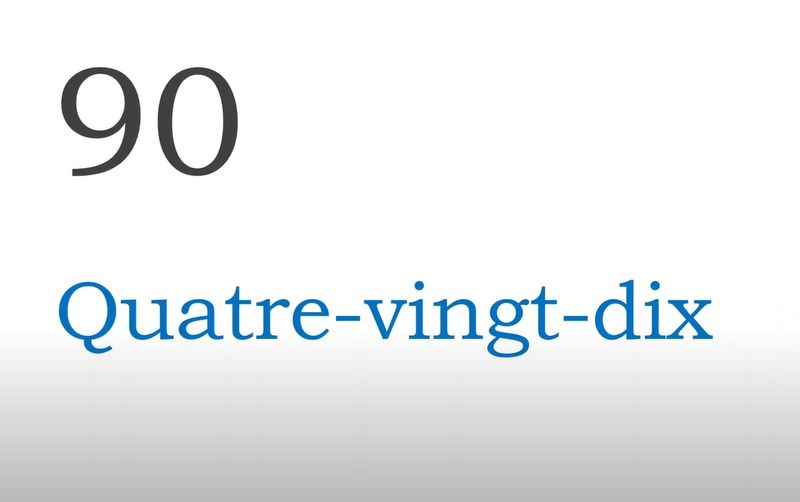
For this grouping, you have the same first two words as the eighties (quatre-vingt), but add teens instead of single numbers.
For example, 90 literally means "four-twenty-ten" because it is twenty times four plus ten (20 x 4 + 10), and 91 means "four-twenty-eleven" (20 x 4 + 11).
See the direct translations next to each of these numbers below so you can understand what each word means.
90 quatre-vingt-dix (four twenty ten) kat-re van dees
91 quatre-vingt-onze (see above)
92 quatre-vingt-douze (four twenty twelve)
93 quatre-vingt-treize (four twenty thirteen)
94 quatre-vingt-quatorze (four twenty fourteen)
95 quatre-vingt-quinze (four twenty fifteen)
96 quatre-vingt-seize (four twenty sixteen)
97 quatre-vingt-dix-sept (f0ur twenty seventeen)
98 quatre-vingt-dix-huit (four twenty eighteen)
99 quatre-vingt-dix-neuf (four twenty nineteen)
French Numbers in the 100s
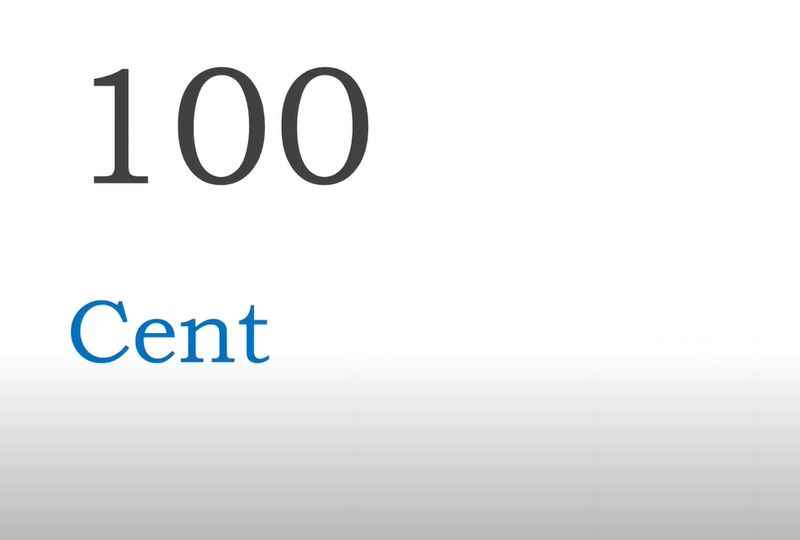
The triple digits have the same system as above, but they add the word cent to the front.
For numbers in the 100s, each French number will start with cent and add from there.
Below are a few examples of different combinations.
100 cent san
118 cent dix huit
122 cent vingt deux
124 cent vingt quatre
177 100 cent + 77 soixante dix sept = cent soixante dix sept
181 cent quatre vingt un
188 cent quatre vingt huit
194 cent quatre-vingt-quatorze
Numbers Above 200 in French
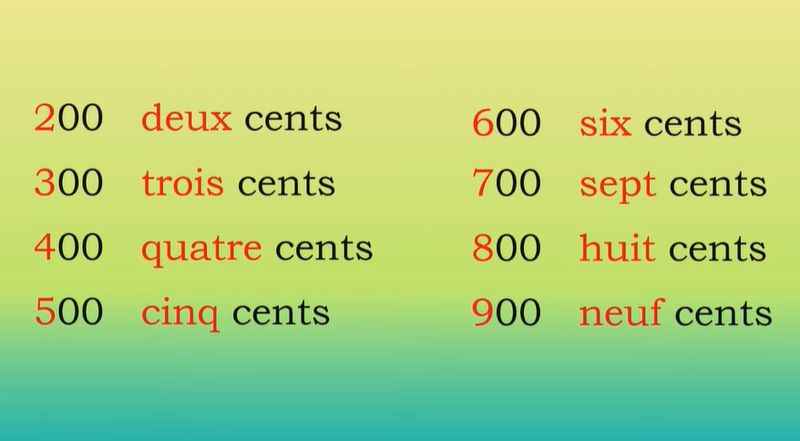
Each triple-digit number in French after the 100s will continue to use cent or cents. However, it will have a single digit before this word depending on what the number is.
For example, a number like 700 will start with sept (seven) and end with cents.
Based on this rule, the full name for 700 is sept cents.
Below, you can check out several examples of different types of triple digit numbers so that you can see all of the different ways in which they are written.
200 deux cents
217 deux cent dix sept
283 deux cent quatre vingt trois
295 deux cent quatre vingt quinze
298 deux cent quatre-vingt-dix-huit
300 trois cents
321 troi cent vingt et un
373 trois cent soixante treize
387 trois cent vingt sept
390 trois cent quatre vingt dix
399 trois cent quatre-vingt-dix-neuf
400 quatre cents
479 quatre cent soixante dix neuf
480 quatre cent quatre vingts
492 quatre cent quatre vingt douze
493 quatre cent quatre vingt treize
500 cinq cents
525 cinq cent vingt cinq
589 cinq cent quatre vingt neuf
597 cinq cent quatre vingt dix sept
685 six cent huitante cinq
688 six cent quatre vingt huit
French Numbers in the 1,000s
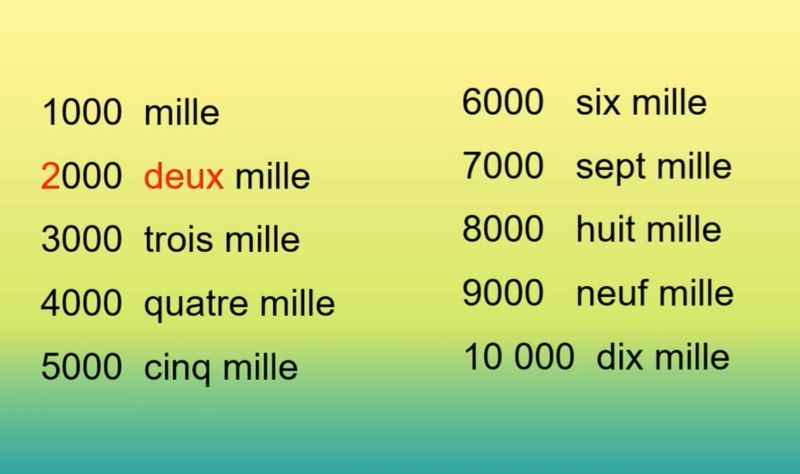
After you have mastered the three-digit numbers, moving on to the four-digit numbers will be a breeze!
Every number follows the same rules that you have learned above, but you will now add a new word, mille, into the mix.
As you can guess, this means one thousand. Below, you can explore a few examples of different combinations of four-digit numbers in French.
If you want to challenge yourself a bit more, try making your own combinations and using the lists above to create the French numbers.
1,000 mille
1,080 mille quatre vingts
1,172 mille cent soixante douze
1,225 mille deux cent vingt cinq
1,991 mille neuf cent quatre vingt onze
3,071 trois mille soixante et onze
5,578 mille cinq cent soixante dix huit
6,000 six mille
Numbers in the Ten Thousands and Above
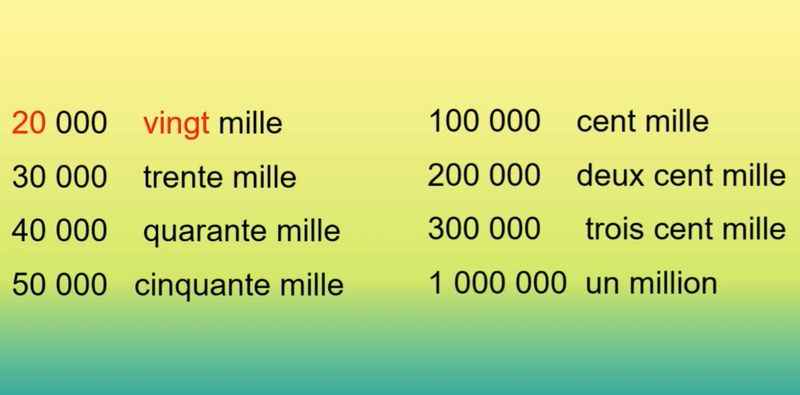
10,000 dix mille
100,000 cent mille
500,000 cinq cent mille
1,000,000 un million
1,000,000,000 un milliard
French Expressions for Counting

Now, let's take a look at some number-related vocabulary in French for various settings.
Mathematics
Plus: plus
Moins: minus
Multiplié par: multiply by
Divisé par: divide by
Pour cent: percent
Years in French
You can say years the exact same way that you would say the French four-digit numbers.
There are a few examples below.
For practice, think about the year you were born and some other important years and try to write them out.
1996: mille neuf cent quatre vingt seize
1899: mille huit cent huitante cinq
2005: deux mille cinq
Ordinals
First - premier/première
Second - deuxième
Third - troisième
Fourth - quatrième
Fifth - cinquième
Sixth - sixième
Seventh - septième
Eighth - huitième
Ninth - neuvième
Tenth - dixième
Summing Up French Numbers: How to Count in French from 1-100+
Congratulations, you have successfully mastered the art of counting in French from 1 to 100 and beyond. Gone are the days when French numbers seemed intimidating or confusing.
Armed with this newfound knowledge, you can confidently navigate any numerical conversation in the French language.
Remember to keep this comprehensive guide on hand as a quick reference whenever you need a reminder. With these charts and your determination, forgetting French numbers will be a thing of the past.
So go ahead, venture out into the world, and astound your friends with your impressive command of French numbers.
You're now equipped to embrace the beauty of this linguistic skill with confidence and grace. Bonne chance!







